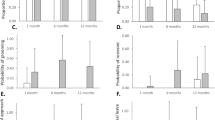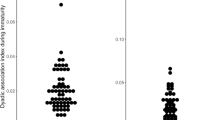Abstract
The dichotomy between the two Pan species, the bonobo (Pan paniscus) and chimpanzee (Pan troglodytes) has been strongly emphasized until very recently. Given that most studies were primarily based on adult individuals, we shifted the “continuity versus discontinuity” discussion to the infant and juvenile stage. Our aim was to test quantitatively, some conflicting statements made in literature considering species differences between immature bonobos and chimpanzees. On one hand it is suggested that infant bonobos show retardation in motor and social development when compared with chimpanzees. Additionally it is expected that the weaning process is more traumatic to chimpanzee than bonobo infants. But on the other hand the development of behaviors is expected to be very similar in both species. We observed eight mother–infant pairs of each species in several European zoos. Our preliminary research partially confirms that immature chimpanzees seem spatially more independent, spending more time at a larger distance from their mother than immature bonobos. However, the other data do not seem to support the hypothesis that bonobo infants show retardation of motor or social development. The development of solitary play, environmental exploration, social play, non-copulatory mounts and aggressive interactions do not differ between the species. Bonobo infants in general even groom other group members more than chimpanzee infants. We also found that older bonobo infants have more nipple contact than same aged chimpanzees and that the weaning process seems to end later for bonobos than for immature chimpanzee. Additionally, although immature bonobos show in general more signs of distress, our data suggest that the weaning period itself is more traumatic for chimpanzees.





Similar content being viewed by others
References
Altmann J (1974) Observational study of behavior: sampling methods. Behaviour 49:227–267
Clark CB (1977) A preliminary report on weaning among chimpanzees of the Gombe National Park, Tanzania. In: Chevalier-Skolnikoff S, Poirier FE (eds) Primate bio-social development: biological, social and ecological determinants. Garland Publishing Inc, New York, pp 235–260
De Plooij FX (1984) The behavioural development of free-living chimpanzee babies and infants. ABLEX Publishing Corporation, Norwood, NJ
De Waal FBM (1987) Tension regulation and nonreproductive functions of sex in captive bonobos (Pan paniscus). Nat Geogr Res 3(3):318–335
De Waal FBM (1989) Behavioral contrasts between bonobo and chimpanzee. In: Heltne PG, Marquardt LA (eds) Understanding chimpanzees. Harvard University Press, Cambridge, pp154–175
De Waal FBM (1998) Reply to Stanford CB (1998) The social behavior of chimpanzees and bonobos: empirical evidence and shifting assumptions. Curr Anthropol 39(4):407–408
De Lathouwers M, Van Elsacker L (2004) Comparing maternal styles in bonobos (Pan paniscus) and chimpanzees (Pan troglodytes). Am J Primatol 64:411–423
De Lathouwers M, Van Elsacker L (2005) Reproductive parameters of female Pan paniscus and P. troglodytes: quality versus quantity. Int J Primatol 26(1):55–71
Doran DM, Jungers WL, Sugiyama Y, Fleagle JG, Heesy CP (2002) Multivariate and phylogenetic approaches to understanding chimpanzee and bonobo behavioral diversity. In: Boesch C, Hohmann G, Marchant LF (eds) Behavioural diversity in chimpanzees and bonobos. Cambridge University Press, New York, pp14–34
Enomoto T (1990) Social play and sexual behavior of the bonobo (Pan paniscus) with special reference to flexibility. Primates 31(4):469–480
Fritz J, Howell SM, Hogan H, Nankivell B, Nash L (1991) Weaning in captive chimpanzees (Pan troglodytes): as assessed by an easily collected measure. Lab primates Newsl 30(4):13–16
Fruth B, Hohmann G, McGrew WC (1999) The Pan species. In: Dolhinow P, Fuentes A (eds) The nonhuman primates. Mayfield Publishing Company, London Toronto, Essay 7, pp 64–72
Fruth F, Hohmann G (2002) How bonobos handle hunts and harvests: why share food? In: Boesch C, Hohmann G, Marchant LF (eds) Behavioural diversity in chimpanzees and bonobos. Cambridge University Press, Cambridge, pp 231–243
Furuichi T (1997) Agonistic interactions and matrifocal dominance rank of wild bonobos (Pan paniscus) at Wamba. Int J Primatol 18(6):855–875
Hasegawa T, Hiraiwa-Hasegawa M (1983) Opportunistic and restrictive matings among wild chimpanzees in the Mahale Mountains, Tanzania. J Ethol 1:75–85
Hashimoto C, Furuichi T (1994) Social role and development of noncopulatory sexual behavior of wild bonobos. In: Wrangham RW, McGrew WC, de Waal FBM (eds) Chimpanzee cultures. Harvard University Press, Cambridge, MA, pp155–168
Hohmann G (2001) Association and social interactions between strangers and residents in bonobos (Pan paniscus). Primates 42(1):91–99
Hohmann G, Fruth B (2002) Dynamics in social organization of bonobos (Pan paniscus). In: Boesch C, Hohmann G, Marchant LF (eds) Behavioural diversity in chimpanzees and bonobos. Cambridge University Press, New York, pp138–150
Idani G (1991) Social relationships between immigrant and resident bonobo (Pan paniscus) females at Wamba. Folia Primatol 57:83–95
Johnson MJ (1997) Juvenile Bonobo’s (Age 2–5 years). In: Mills J, Reinartz G, De Bois H, Van Elsacker L, Van Puijenbroeck B (eds) The care and management of bonobos (Pan paniscus) in captive environments: a husbandry manual jointly developed for the bonobo species survival Plan and European endangered species program. Zool Soc Milw Cty Milw 2(9):1–9
Kano T (1989) The sexual behavior of pygmy chimpanzees. In: Heltne PG, Marquardt LA (eds) Understanding chimpanzees. Harvard University Press, Cambridge, MA, pp176–183
Kano T (1992) The last Ape: Pygmy chimpanzee behavior and ecology. Stanford University Press, Stanford
Kano T (1996) Male rank order and copulation rate in a unit-group of bonobos at Wamba, Zaïre. In: McGrew WC, Marchant LF, Nishida T (eds) Great Ape societies. Cambridge University Press, Cambridge, pp 92–103
Kano T (1998) Reply to Stanford CB (1998) The social behavior of chimpanzees and bonobos: empirical evidence and shifting assumptions. Curr Anthropol 39(4):410–411
Kitamura K (1989) Genito-genital contacts in the pygmy chimpanzee (Pan paniscus). Afr Study Monogr 10(2):49–67
Kuroda S (1980) Social behavior of the pygmy chimpanzees. Primates 21:181–197
Kuroda S (1989) Developmental retardation and behavioral characterisitcs of Pygmy chimpanzees. In: Heltne PG, Marquardt AE (eds) Understanding chimpanzees. Chicago Academy of Sciences, Chicago, pp184–193
Kuroda S (2000) Developmental retardation in early infancy of Pygmy Chimpanzees in Wamba. Behavioural diversity in chimpanzees and bonobos. Abstract Book 11–17 June, Seeon, pp 16
Muniz RS (1984) Nipple contact in captive black-faced chimpanzees (Pan t. troglodytes Blumenbach, 1779). Zoo Biol 3(3):267–271
Palagi E, Paoli T, Tarli SB (2004) Reconciliation and consolation in captive bonobos (Pan paniscus). Am J Primatol 62(1):15–30
Parish AR (1996) Female relationships in bonobos (Pan paniscus): evidence for bonding, cooperation, and female dominance in a male-philopatric species. Hum Nat 7:61–96
Sokal RR, Rohlf FJ (1981) Biometry. 2nd edn. Freeman, NY
Stanford CB (1998) The social behavior of chimpanzees and bonobos: empirical evidence and shifting assumptions. Curr Anthropol 39(4):399–420
Stevens J, Vervaecke H, Van Elsacker L (2001) Sexual strategies in Pan paniscus: implications of female dominance. Primate Rep Spec issue 60(1):42–43
Stevens J, Vervaecke H, Van Elsacker L (2003) Mating harassment in captive bonobos (Pan paniscus). Primates Eye 80:22–23
Van Lawick-Goodall J (1967) Mother-offspring relationships in free-ranging chimpanzees. In: Morris D (ed) Primate ethology. Weidenfeld and Nicolson, London, pp 287–346
van Lawick-Goodall J (1968) The behaviour of free-living chimpanzees in the Gombe Stream Reserve. An Behav Mono 1:165–311
Verbeke G, Molenberghs G (1997) Linear mixed models in practice: a SAS-oriented approach. Spinger-Verlag, New York
Vervaecke H, De Vries H, Van Elsacker L (2000) Dominance and its behavioral measures in a captive group of bonobos (Pan paniscus). Int J Primatol 21:47–68
Vervaecke H, Stevens J, Van Elsacker L (2003a) Bonobos on the bandwagon. Abstract Book International Anthropological Congress Anthropology and society, May 22–24, Prague
Vervaecke H, Stevens J, Van Elsacker L (2003b) Interfering with others: female-female reproductive competition in Pan paniscus. In: Jones CB (eds) Sexual selection and reproductive competition in primates: new perspectives and directions. American Society of Primatologists, pp 231–253
Weaver ACF (1997) Bonobo infant development in the first year compared to the other Apes. In: Mills J, Reinartz G, De Bois H, Van Elsacker L, Van Puijenbroeck B (eds) The care and management of bonobos (Pan paniscus) in captive environments: a husbandry manual jointly developed for the Bonobo species survival plan and European endangered species program. Zool Soc Milw Cty Milw 2(8):1–15
Acknowledgements
We kindly thank the curators, staff members, assistants, and keepers of the following institutions for their kind co-operation: Animal Park Amersfoort, Burgers’ Zoo, Edinburgh Zoo, Frankfurt Zoo, Primate Park Apenheul, Wild Animal Park Planckendael, Wuppertal Zoo. The assistance of the members of the Center for Research and Conservation is much appreciated. We thank the Flemish Government for the structural support to the Center for Research and Conservation (CRC) of the Royal Zoological Society of Antwerp (RZSA). The first author received a BOF-Dehousse grant (October 2000–September 2001) from the University of Antwerp and a Dehousse grant (February 2002–January 2004) from the Royal Zoological Society of Antwerp in association with the University of Antwerp, Belgium.
Author information
Authors and Affiliations
Corresponding author
About this article
Cite this article
De Lathouwers, M., Van Elsacker, L. Comparing infant and juvenile behavior in bonobos (Pan paniscus) and chimpanzees (Pan troglodytes): a preliminary study. Primates 47, 287–293 (2006). https://doi.org/10.1007/s10329-006-0179-7
Received:
Accepted:
Published:
Issue Date:
DOI: https://doi.org/10.1007/s10329-006-0179-7




